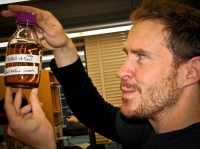CAZypedia needs your help! We have many unassigned GH, PL, CE, AA, GT, and CBM pages in need of Authors and Responsible Curators.
Scientists at all career stages, including students, are welcome to contribute to CAZypedia. Read more here, and in the 10th anniversary article in Glycobiology.
New to the CAZy classification? Read this first.
*
Consider attending the 15th Carbohydrate Bioengineering Meeting in Ghent, 5-8 May 2024.
User:Jan-Hendrik Hehemann
Short CV
I studied biochemistry and molecular biology at the University of Hamburg (Germany) and graduated in 2005.
In 2006 I received an early stage Marie Curie fellowship to start a PhD, with Dr. Mirjam Czjzek at the Station Biologique de Roscoff(France).
Since March 2010, I am working as a PostDoc with ^^^Alisdair Boraston^^^ at the University of Victoria (Canada). In August 2010, I received an EMBO Long-Term Fellowship to work on Bacteroides plebeius and aspects of how this microbe has benefitted through its uptake of CAZymes from the sea.
Research Interests
I am very interested in organic matter degradation in the ocean and how marine bacteria degrade algal polysaccharides. This is an exciting and important field of research because compared to CAZymes acting on terrestrial plant polysaccharides we know little about CAZymes used to degrade marine algae. This impedes our understanding of the ocean carbon cycle and the use of CAZymes for the generation of biofuels from seaweeds. In addition I am interested in the evolution of human gut microbes and how they respond to "new" polysaccharides in our foods.
Previous research - "The Sushi Factor"
During my PhD I worked on glycoside hydrolases from the marine flavobacterium Zobellia galactanivorans that are specific for cell wall polysaccharides from red algae. I focused on a new subfamily in GH16, of which the specificity was unknown, and discovered that they are beta-porphyranases. These enzymes degrade the polysaccharide porphyran from red seaweeds like Porphyra sp., which is more generally known as Nori, and used to make one of my favourite foods: the Maki-Sushi roll.
When we searched for other porphyranases in public sequence databases, we found them solely in genomes of marine bacteria - and not in terrestrial bacteria - probably because porphyran is an algal polysaccharide and is thus absent in land plants. However, we found one notable exception: one porphyranase was encoded in the genome of Bacteroides plebeius, a human gut bacterium that was isolated from a Japanese individual.
A subsequent analysis of available gut metagenome datasets revealed that porphyranases are common in gut bacteria from Japanese people and so far absent in others. We suggested that the consumption of fresh, non-sterile, food with associated bacteria - “The Sushi Factor” - created contact between the human gut and bacteria from the ocean, which led to the horizontal transfer of porphyranase genes [1]. This research was widely covered in the press; you can find a great and more palatable article about our paper here.
